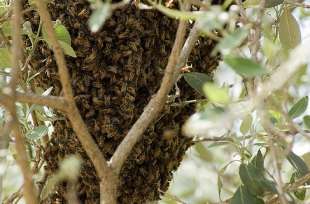Bees work together to keep cluster cool

Research published today in the Royal Society journal Interface has shed some light on how swarming bees stay warm in the cold and avoid getting too hot.
Swarming is an essential part of honeybee behaviour. When a fertilized queen leaves the hive she takes a swarm of bees with her to start a new colony. Up to 20000 bees might accompany a newly fertilised queen bee on her quest. These bees usually form a cluster and cling to each other for several days whilst scouts leave to search for a new home to relocate to. The bees, exposed to the outside temperature, are at risk of getting too cold but in their tightly packed cluster they may also become too hot.
Clusters of bees seem to act as one autonomous body to these changing temperatures. Whilst each bee only has information from its own local environment the cluster as a whole responds cooperatively to maintain a temperature inside of within a few degrees of 35°C. Researchers from MIT set about designing a mathematical model which would explain how clusters of bees can respond cooperatively without a central controller.
Bee clusters have two major parts. Around the outside of the cluster the bees are densely packed together forming a mantle, whilst within the core of the cluster the bees are more sparsely packed. When air temperature is cool the mantle becomes more densely packed and the cluster contracts, keeping the heat within. In high ambient temperatures the cluster expands and the mantle spreads out to prevent over heating in the core.
Most models used to describe this thermoregulation process rely on individual bees knowing their location and the size of the cluster. More recent models work on the assumption that bees in the cluster can only know the temperatures at their locations. But these models are unable to explain why the cluster collectively reacts to stay warm in low temperatures.
The model created by researchers led by Samuel Ocko uses the idea that cold bees prefer to huddle densely and hot bees like to be more sparsely packed. Cold bees attempt to push themselves towards higher temperatures which creates what the team call a 'behavioural pressure'. The bees seek to minimise this pressure by changing their packing. Using a series of equations the team have found that minimising behavioural pressure local bee packing mathematically relates both to local temperature and outside temperature. Their model suggests that bees respond to their local conditions and move accordingly and that this causes variations in packing which can propagate information about ambient air temperature throughout the cluster.
With this method bees can share information across the cluster to work together to maintain constant temperatures in the swarm. The model shows bees' extraordinary ability to act as a collective. The team suggest that in the cluster individuals can work so closely because 'the difference between the individual and the collective is nearly non-existent'.
More information: Samuel A. Ocko and L. Mahadevan. "Collective thermoregulation in bee clusters. " J. R. Soc. Interface February 6, 2014 11 91 20131033; DOI: 10.1098/rsif.2013.1033 1742-5662
Journal information: Journal of the Royal Society Interface
Provided by The Royal Society



















